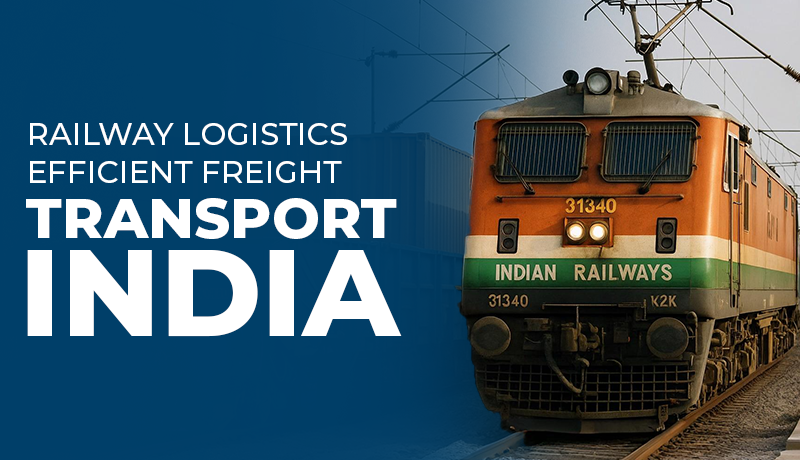Railway Logistics: Efficient Freight Transport Across India
Introduction to Railway Logistics
Railway logistics is a crucial component of India’s freight transport system, offering a highly efficient and reliable mode for moving bulk goods over long distances. Leveraging India’s vast rail network, railway logistics facilitates the transportation of raw materials, finished products, and essential commodities in a cost-effective and environmentally friendly way.
Why Railway Logistics is Important in India
India’s geography and economic diversity make railways an indispensable logistics backbone. With over 67,000 kilometers of track, Indian Railways is among the largest rail networks globally, connecting remote areas and industrial hubs alike.
Railway logistics offers several advantages:
- Cost-Effectiveness: Rail freight is more economical for heavy and bulk shipments compared to road transport.
- Environmental Sustainability: Trains produce lower greenhouse gas emissions per ton-kilometer than trucks, helping businesses reduce their carbon footprint.
- High Capacity: Trains can carry large volumes of goods in one trip, reducing the number of vehicles on roads.
- Reliable Scheduling: Indian Railways operates on fixed schedules, making freight planning more predictable.
Types of Goods Transported via Railway Logistics
Railway logistics caters to diverse industries with different cargo types:
- Coal and Minerals: Bulk transport for power plants and manufacturing.
- Automobiles: Movement of vehicles and parts between factories and dealerships.
- Food Grains and Agriculture Products: Transport to markets and processing centers.
- Containers and Palletized Cargo: Multi-modal shipments integrated with road transport.
- Industrial Goods: Chemicals, steel, cement, and machinery parts.
Key Features of Railway Logistics Services
Modern railway logistics services integrate traditional rail freight with technology and supply chain solutions:
- Containerized Freight Services: Use of standardized containers for easier handling and intermodal transport.
- Railway Freight Terminals (RFTs): Specialized hubs for cargo consolidation, warehousing, and distribution.
- Real-Time Tracking: GPS and IoT-enabled tracking of rail shipments for transparency.
- Dedicated Freight Corridors: High-speed rail lines designed to increase cargo capacity and reduce delays.
- End-to-End Solutions: Integration of rail with road transport for door-to-door delivery.
Advantages of Railway Logistics Over Other Modes
While road and air transport remain essential for many deliveries, railway logistics offers distinct benefits for freight movement:
- Lower Transportation Costs: Especially for heavy, bulky cargo over long distances.
- Reduced Road Congestion: Moving freight by rail decreases truck traffic and road wear.
- Enhanced Safety: Rail freight has fewer accidents and product damages compared to road transport.
- Energy Efficiency: Railways consume less energy per ton of cargo moved.
Challenges in Railway Logistics
Despite its benefits, railway logistics faces some hurdles in India:
- Last Mile Connectivity: Rail freight often requires road transport for final delivery.
- Infrastructure Limitations: Need for more modern terminals and upgraded rail tracks.
- Scheduling Conflicts: Passenger trains often take precedence, causing freight delays.
- Complex Paperwork: Documentation and regulatory compliance can slow operations.
Recent Developments in Indian Railway Logistics
The Indian government and Indian Railways have been aggressively investing in improving railway logistics:
- Dedicated Freight Corridors (DFC): Projects like the Eastern and Western DFCs aim to create faster and more efficient freight routes.
- Private Sector Participation: Encouraging private operators to run container trains and manage freight terminals.
- Digital Initiatives: Implementation of e-way bills, online booking, and freight tracking systems.
- Green Initiatives: Promoting electrification and energy-efficient rail operations.
How Businesses Benefit from Railway Logistics
For manufacturers, retailers, and exporters, railway logistics presents a strategic advantage:
- Cost Savings: Lower freight charges compared to air and road for bulk shipments.
- Supply Chain Reliability: Predictable transit times enable better inventory management.
- Environmental Compliance: Supports corporate sustainability goals.
- Wide Reach: Access to hinterlands and industrial zones through rail connectivity.
Future Outlook of Railway Logistics in India
With ongoing infrastructure development and technology integration, the future of railway logistics in India looks promising. The expansion of multimodal logistics parks, enhanced freight corridors, and private sector engagement will transform railway logistics into a faster, more flexible, and customer-centric service.
Railway logistics will continue to play a vital role in India's economic growth by ensuring efficient movement of goods across regions, reducing transportation costs, and lowering environmental impact.
Conclusion
Railway logistics stands as a backbone for India’s freight transport system, combining cost-efficiency, sustainability, and large-scale capacity. Businesses looking to optimize their supply chains should consider leveraging rail freight solutions for bulk and long-distance shipments.
Choosing the right railway logistics partner can significantly improve delivery timelines, reduce costs, and contribute to greener supply chain operations in India.



